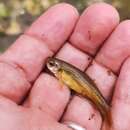Biology
provided by Arkive
The daska is a short-lived species (2) with a high level of resilience, capable of quickly re-establishing depleted sub-populations (1). Spawning occurs from December to March, and the diet includes invertebrates and plants (2).
Conservation
provided by Arkive
There are currently no known conservation measures targeting this species.
Description
provided by Arkive
Typical of most cyprinids, the daska is a small, silvery-brown fish, sometimes with a slight purplish sheen in the light, but no remarkable colours or pattern. The fins and tail are virtually transparent, and the tail is forked.
Habitat
provided by Arkive
Occurs in springs and associated wetlands and in lowland water courses with little current (2).
Range
provided by Arkive
Restricted to parts of the Peloponnese, Aitolo-Akarnania and Lefkas Island, Greece (1) (2).
Status
provided by Arkive
Classified as Least Concern (LC) on the IUCN Red List 2006 (1), and listed on Appendix III of the Bern Convention (2).
Threats
provided by Arkive
The daska is threatened by water extraction and pollution within its range, although in general the population is considered safe with no apparent long-term decline. While some local sub-populations have been severely impacted, many are expected to recover if conditions improve, because of this species' ability to quickly rebound from depleted numbers (1).
Trophic Strategy
provided by Fishbase
Feeds on plants and invertebrates (Ref. 28587).
Biology
provided by Fishbase
A short-lived species which occurs in spring and associated wetlands and in lowland water courses with little current. Feeds on invertebrates and plants. Is threatened due to water abstraction and habitat destruction. Spawns in December to March (Ref. 26100).
Importance
provided by Fishbase
fisheries: of no interest
Pelasgus stymphalicus
provided by wikipedia EN
Pelasgus stymphalicus, also known as the dáska or stymphalia minnow, is a threatened species of small freshwater fish. It is a short-lived species, and reaches a maximum length of 12 cm.
P. stymphalicus is endemic to slow-flowing rivers and wetlands in the Peloponnese and disjunctly in Lake Stymphalia, a natural eutrophic lake without surface drainage. The main threats to P. stymphalicus are habitat destruction, water extraction and pollution, although the species is resilient and well-adapted to unstable conditions. It is protected under Appendix II of the EU's Habitats Directive (1992) and under Appendix III of the Bern Convention, (1982).[2]
References
- Economidis, P.S., 1995, Endangered freshwater fishes of Greece., Biological Conservation, 72, 201-211
- Crivelli, A.J., 1996. The freshwater fish endemic to the Mediterranean region. An action plan for their conservation.. Tour du Valat Publication, 171 p.
- Early development of Pseudophoxinus stymphalicus (Cyprinidae) from lake Trichonis, Greece Daoulas C. ; Psarras T. ; Barbieri T - Seliki R. ; Economou A. N. ; Cybium (Cybium) ISSN 0399-0974, 1995

- license
- cc-by-sa-3.0
- copyright
- Wikipedia authors and editors
Pelasgus stymphalicus: Brief Summary
provided by wikipedia EN
Pelasgus stymphalicus, also known as the dáska or stymphalia minnow, is a threatened species of small freshwater fish. It is a short-lived species, and reaches a maximum length of 12 cm.
P. stymphalicus is endemic to slow-flowing rivers and wetlands in the Peloponnese and disjunctly in Lake Stymphalia, a natural eutrophic lake without surface drainage. The main threats to P. stymphalicus are habitat destruction, water extraction and pollution, although the species is resilient and well-adapted to unstable conditions. It is protected under Appendix II of the EU's Habitats Directive (1992) and under Appendix III of the Bern Convention, (1982).
- license
- cc-by-sa-3.0
- copyright
- Wikipedia authors and editors

